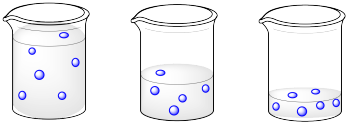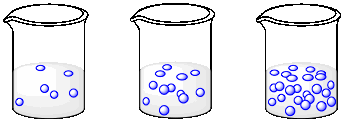
Reactivity in Chemistry
Reaction Kinetics
RK7. Collisions and Concentration
We know that in order for two molecules to react with each other, they must first contact each other. We think of that contact as a "collision". The more mobile the molecules are, the more likely they are to collide. Also, the closer the molecules are together, the more likely they are to collide.
In the following drawings, the molecules are closer together in the picture on the right than they are in the picture on the left. The molecules are more likely to collide and react in the picture on the right.

Figure RK7.1. Concentration affects the likelihood of a collision between molecules.
We might describe the two drawing above in terms of population density. Both drawings appear to offer the same amount of space, but they have different amounts of molecules in them.
The difference is a lot like the difference between human population densities in various locations around the world. Some places, such as Mexico City or Tokyo, are very crowded; they have high population densities. Some places, such as the Australian Outback or the Canadian Arctic, have low population densities.
Problem RK7.1.
In which location do you think you are likely to bump into another person: the Upper East Side of New York City or 75 degrees north, 45 degrees west, Greenland?
Problem RK7.2.
Rank the following places in terms of population density (the number of people per square kilometer).
a) Russia: pop. 143 million; area 17 million km2
b) Bahrain: pop. 1.2 million; area 750 km2
c) Argentina: pop. 41 million; area 2.7 million km2
d) China: pop. 1.3 billion; area 9.6 million km2
e) Malawi: pop. 15 million; area 118 thousand km2
f) Vatican City: pop. 850; area 0.44 km2
g) Jamaica: pop. 2.7 million; area 10,990 km2
Sometimes, a lot of people are living in a small area, and the population density is high. Sometimes, the population is large, but the area is, too. Population density depends on two different factors: the number of people and the area in which they are spread out.
Concentration is the term we use to describe the population density of molecules (and other chemical entities such as atoms or ions). It describes the number of molecules there are, but also how much room, or volume, they have to move around. Thus, whereas a human population density may be described in terms of people per square kilometer, the concentration of a solution may be described in terms of molecules per liter.
Problem RK7.3.
Describe what is happening to the concentrations of the three solutions as you go from left to right.
a)

b)

Problem RK7.4.
In the cases above, describe what would happen to rates of collisions between molecules as you go from right to left in the drawings.
Problem RK7.5.
a) In the following drawings, state what is happeing to the concentration of molecules of each type as you go from left to right.

b) Explain what would happen to the rate of collisions between red molecules and blue molecules as you move from left to right.
c) How would your answer about rates change if the situation here were reversed: if the number of blue molecules stayed the same and the number of red molecules increased?
d) How would your answer about rates change if the numbers of both the red and the blue molecules were increasing at the same time?
We usually don't count individual molecules in a solution. We deal with groups of molecules because it's more convenient. Individual molecules are just too small to work with. In dealing with molecules in bulk, we usually use a unit called a mole, often abbreviated to mol. It's kind of like dealing with eggs by the dozen. Molecules are easier to keep track of by the mole, rather than individually.
Problem RK7.7.
a) In the following solutions, how many dozen blue molecules are there in each case?
b) What is happening to the concentration of the beaker as you go from one beaker to the next? Quantify your answer.

In reality, we don't count molecules or even moles of molecules. When we want to work with a compound, we just weigh it out on the balance. We can then use the known weight of the compound to figure out how many moles we have.
Of course, if we are going to be measuring out molecules by weight, we'll need to know how much each molecule weighs. For example, if we need an equal number of red molecules and blue molecules, and red molecules weigh three times as much as blue molecules, we'll need to weigh out three times as much of the red stuff as the blue stuff.

Figure RK7.1. A mixture of larger and smaller molecules.
Problem RK7.7.
You are developing a new "extreme sport" amusement park ride. Each ride (for one person) is powered by one mouse and one elephant. You have plenty of elephants to get started, but will need to go and buy some mice.
a) If an elephant weighs 6,800 kg, how many grams does it weigh?
b) If you have 47,600 kg of elephants, how many rides can you set up?
c) If a mouse weighs 25 g, how many g of mice will you need to buy?
d) Suppose you decide to get three extra mice (sometimes accidents happen around elephants). What is the total weight of mice you would need, including these extras?
Problem RK7.8.
Suppose each of the following beakers contains an equal weight of each kind of molecule. The molecular weight of a blue molecule is 60 g/mol. What is the molecular weight of a red, an orange and a grey molecule?

The weight of a molecule can be determined by adding up the weights of all its atoms. For example, a carbon dioxide molecule has a molecular weight of 44 amu (carbon is 12 amu plus two oxygens at 16 amu apiece). The weight of a mole of carbon dioxide is the same as the molecular weight, but in grams instead of amu. A mole of carbon dioxide is 44 g. In other words, the molecular weight (MW) of carbon is 44 g/mol.
Problem RK7.9.
How much does a mole of each of the following molecules weigh?
a) nitric oxide, NO2
b) glucose, C6H12O6
c) benzaldehyde, C7H6O
d) phosphorus pentoxide, P2O5
Problem RK5.10.
How many moles of each of the following compounds are there in the given weights?
a) 3 grams of glucose
b) 10 grams of benzaldehyde
c) 30 grams of phosphorus pentoxide
Problem RK5.11.
What is the concentration of each of the following solutions (in moles per liter)?
a) 5 g of glucose in 50 mL of water
b) 11 g of benzaldehyde in 25 mL of THF
c) 9 g of menthol (MW 156 g/mol) in 60 mL of DMF
This site was written by Chris P. Schaller, Ph.D., College of Saint Benedict / Saint John's University (retired) with other authors as noted on individual pages. It is freely available for educational use.

Structure & Reactivity in Organic,
Biological and Inorganic Chemistry by
Chris Schaller
is licensed under a
Creative Commons Attribution-NonCommercial 3.0 Unported License.
Send corrections to cschaller@csbsju.edu
This material is based upon work supported by the National Science Foundation under Grant No. 1043566.
Any opinions, findings, and conclusions or recommendations expressed in this material are those of the author(s) and do not necessarily reflect the views of the National Science Foundation.
Navigation:
Back to Web Materials on Structure & Reactivity in Chemistry